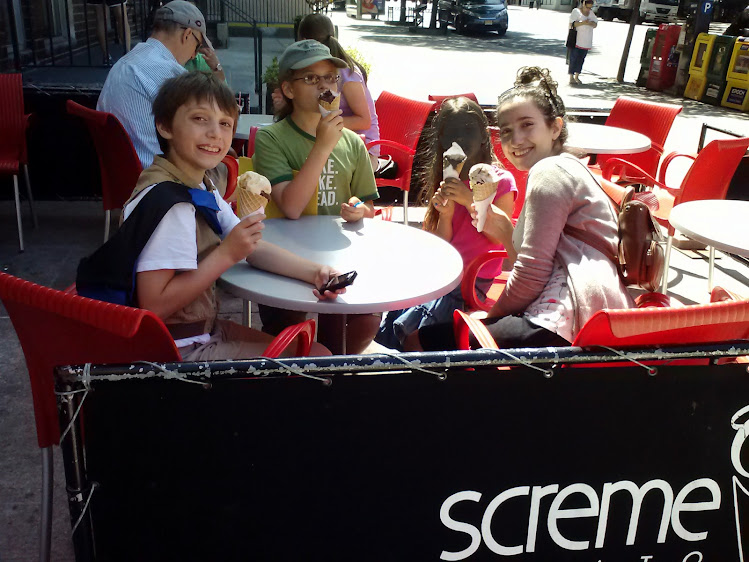Explorers came from Jewish Day School and public school backgrounds, some had attended Hebrew school and some were fully conversant in Hebrew. Each student was paired with a madricha (Language Guide) who encouraged conversation and supported the learning process. All showed dramatic improvement in their skills during the course of the week.
The Madrichot had completed last years' Leaders Fellowship, where they learned about language acquisition, lesson planning and how to foster strategy development in Hebrew language learners. They are leaders in their own school communities and are committed to the goal of revitalizing Hebrew language in fun settings.
Over the five days, the Explorers learned how to pay attention to the strategies they used to understand the spoken Hebrew and written activities. They spent time drafting scripts for screen plays about the venues and shared helpful tips with each other. We were very pleased to watch the Explorers gain confidence in speaking Hebrew throughout the week and are proud of their linguistic discoveries.
As they return to school this fall, we expect that their performance in all subjects will benefit from the language strategies and cognitive skills they acquired during this week.
Here is a brief recap of our week and what the Explorers had to say about their experiences:
DAY ONE: Lower East Side Tasting Tour
| Teambuilding: Find that בָּקְבּוּק! יְמִינָה, שְֹמאֹלָה, קָדִימָה... (Find that bottle... right, left, forward...) |
| Essex Street Market בִּינְגוֹ (bingo) |
"אֵיפֹה פִּיתָה" (Where's the pita)?
"Hey... is banana really בָּנָנָה (banana) in Hebrew?"
| Screenwriting at the Eldridge Street Synagogue |
 |
| Yum, חַמוּצִים (pickles)! |
"I pretended I knew what to do & followed the others. It was my first day hearing spoken Hebrew!"
"I especially enjoyed the pickles!"
"I learned the names of lots of foods in the Bingo game."
DAY TWO: שָֹפָה וְטֶבָע Language and Nature
 |
| Flower scavenger hunt in the Conservatory Garden |
| שִֹיחוֹת (discussions) at the Jewish Museum |
"I asked questions."
"I learned to say 'wheels' and 'raccoon'"
| !הַמָדְרִיכוֹת הַיָפוֹת (Our lovely counselors!) |
| Reflecting on the art of language. |
"The painting that I loved is called 'Misunderstandings' because it is so abstract."
"I learned names of plants!"
DAY THREE: פֶּסֶל הַחֵרוּת (Statue of Liberty)!
| Partners in historical discovery... |
| "Give me your tired, your poor, your huddled masses yearning to breathe free.... I lift my lamp beside your golden door." --Emma Lazarus |
| Crowning ourselves: "Lady Liberty's Attendants" |
Conversations overheard in Hebrew:
"I liked speaking in Hebrew because I used new words."
"I never knew you could go inside the statue!"
"Did you know how long it took to build her?"
"Learning Hebrew בָּחוּץ (outside) is fun!"
DAY FOUR: Life and Video
"After Tuesday, I found myself thinking in Hebrew... but since I didn't know all the words yet, I couldn't quite understand my own thoughts. Today it's making more sense!
"I never knew you could go inside the statue!"
"Did you know how long it took to build her?"
"Learning Hebrew בָּחוּץ (outside) is fun!"
DAY FOUR: Life and Video
|
| Fun with the פֶּנְגְוִוינִים (penguins)! |
| Can you jump as far as a נַמֵר (leopard)? |
"After Tuesday, I found myself thinking in Hebrew... but since I didn't know all the words yet, I couldn't quite understand my own thoughts. Today it's making more sense!
"At the zoo, I learned how to describe animals and the names of animals I didn't know before. "
"We created a news broadcast and interviewed the animals. We asked them what their names were in Hebrew. I was the Director!"
DAY FIVE: Nature Walk & Ice cream
 |
| Ordering Gelato in Hebrew. |
After a week of speaking in Hebrew, Explorers had the following to say about their experience:
"I learned conversation skills and that Mel Bochner is awesome!"
"I feel proud of my progress."
"I didn't know that I knew enough Hebrew to speak for a whole day... but know I know I can. And I feel proud!"
"We played Taboo... I see how you can play Taboo in your head when you are looking for the right word"
"Yum, delicious day!"
We invite you to join us for more language adventures with City Explorers during school vacations in December, June and August.
Visit http://www.strategichebrew.com/strategic-hebrew-city-explorers.html for more details!





